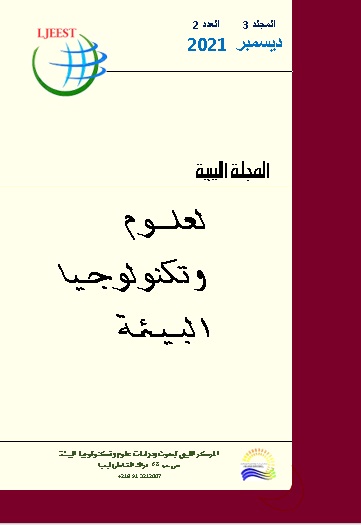التنوع الحيوي لمفصليات نثار الأوراق بغابة النصر طرابلس، ليبيا
DOI:
https://doi.org/10.63359/wx8x7e02الكلمات المفتاحية:
الغابات، الكوليمبولان، العث، الصنوبريات، الكافور، التنوع البيولوجي، ليبياالملخص
أظهرت النتائج الشهرية باستخدام أقماع بيرليزي وجود اختلافات في الكثافة العددية للحيوانات الدقيقة المرتبطة بأشجار الأيوكالبتوس أو الكافور Eucalyptus camaldulensis والصنوبر Pinus halepensis والعوامل المناخية في غابة النصر بطرابلس لإجمالي 120 عينة من نثار الأوراق لسنة 2009. بلغ إجمالي الكثافة العددية للحيوانات الدقيقة السنوية 119.770 فردًا / 15 cm/ m³ من نثار الأوراق. أوضحت النتائج أن الكثافة العددية للكوليمبولا كان فعالاً في تفكك وتكسير نثار الأوراق، والحلم كمفترسات، والفطريات والبكتيريا لتحلل نثار الأوراق. تم تقسيم الدراسة إلى فترتين. (1) مايو - أكتوبر، أظهرت أن متوسط وفرة الحلم كان 24.8، والكوليمبولا 42، والحيوانات الدقيقة الأخرى 100 فرد/ 15 cm / m³ من نثار الأوراق على التوالي. (2) نوفمبر- أبريل، أظهرت أن متوسط وفرة الحلم كان 95، والكوليمبولا 135، ومجموعة الحيوانات الدقيقة الأخرى 100 فرداً / 15 cm/ m³ نثار الأوراق على التوالي. أوضحت الدراسة وجود فروق ذات دلالة معنوية عند المستوى 0.001 وفي اختبار Duncan عند المستوى 0.001 بين شهر يناير والأشهر الأخرى. تم عرض جميع البيانات البيولوجية والكيميائية والفيزيائية المؤثرة على التنوع البيولوجي لمفصليات الأرجل ونثار أوراق الكافور والصنوبر في غابة النصر بطرابلس. توصي الدراسة بالنظر في أهمية تعريف وتصنيف والتنوع البيولوجي للحيوانات الدقيقة والعوامل المختلفة المرتبطة بنثار الأوراق كمؤشرات بيئية مهمة واستدامة النظام البيئي للغابات في ليبيا.
المراجع
Beare MH, Hendrix P.F, Cheng W. 1992. Microbial and faunal interactions and effects on litter nitrogen and decomposition in agroecosystems. Ecological Monographs 62: 569-591.
Berg, B., and R. Laskowski. 2006. Litter decomposition: a guide to carbon and nutrient turnover. Elsevier, Amsterdam, Amsterdam. 120.
Berlese, A. 1905. Apparecchio per raccogliere presto ed in gran numero piccoli Artropodi. In: Redia. Vol. 2, pp. 85-90.
Coleman, D C. 2013. Soil Biota, Soil Systems, and Processes, Editor(s): Simon A Levin, Encyclopaedia of Biodiversity (Second Edition), Academic Press, Pages 580-589.
Conci, C; Poggi, R. 1996. Iconography of Italian Entomologists, with essential biographical data. Mem. Soc. Ent. Ital. 75 159-382, Portrait.
Coyle, D.R.; Nagendra, U.J.; Taylor, M.K.; Campbell, J.H.; Cunard, C.E.; Joslin, A.H.; Mundepi, A.; Phillips, C.A.; Callaham, M.A. 2017. Soil fauna responses to natural disturbances, invasive species, and global climate change: Current state of the science and a call to action. Soil Biol. Biochem., 110, 116–133.
Díaz, D. 2001. Ecosystem Function Measurement, Terrestrial Communities, Editor (s): Simon Asher Levin, Encyclopaedia of Biodiversity, Elsevier, Pages 321-344.
Feller, U. and Fischer, A. 1994. Nitrogen metabolism in senescing leaves. - Critical Reviews in Plant Sciences 13: 241-273.
Franco, R. 2016. Fauna edáfica sob modelos em estágio inicial de restauração de floresta subtropical. (Doctoral Thesis). Universidade Tecnológica Federal do Paraná, Pato Branco, Paraná.
García-Palacios, P.; Maestre, F.T.; Kattge, J.; Wall, D.H. 2013. Climate and litter quality differently modulate the effects of soil fauna on litter decomposition across biomes. Ecol. Lett., 16, 1045–1053.
Gerlach, J.; Samways, M.; Pryke, J. 2013. Terrestrial invertebrates as bioindicators: An overview of available taxonomic groups. J. Insect Conserv., 17, 831–850.
Guevara, R.A.D.; M. Rayner; E. Rynolds. 2000. Orientation of specialist and generalist fungivorus ciid beetles to host and non-host odourus. Physiol. Entomol. 25:288-295.
Hasegawa, M., Takeda, H. 1996. Carbon and nutrient dynamics in decomposing pine needle litter in relation to fungal and fauna abundances. Pedobiologia 40,171–184.
Hopkin, S.P. 1997. Biology of the Springtails (Insecta: Collembola). Oxford: Oxford University Press.
Jiménez-Chacón, A. J.; Pablo H.; Luis M.; Lorena G.; and Oscar G. 2018. Fine Scale Determinants of Soil Litter Fauna on a Mediterranean Mixed Oak Forest Invaded by the Exotic Soil-Borne Pathogen Phytophthora cinnamomic. Forests, 9 (1 -16).
Kolkaila, A. M.; A. A. Makawi and S. M. Hammad. 1971. a. Studies on the arthropods and microorganisms of some Libyan soils: soil arthropods and microorganisms from under four fruit trees. Libyan Jur. Sci.1: 21 – 30.
Kolkaila, A. M; S. M. Hammad; Abd - El – Gaffor, A. S. and Makawi, A. A. M. 1971. b. Studies on the arthropods and microorganisms of some Libyan soils: soil arthropods and microorganisms of a hill at El – Marj region. Libyan Jur. Agric. 1: 6 -12.
Luxton, M. 1883b. Studies on the Invertebrate Fauna of New Zealand. V. Pasture Soils on Kaipaki Peat. Pedobiologia 25, p. 135-148.
Maghrabi, H. A. and A. A. Abufayed. 1994. An overview of biodiversity of Libyan ecosystems. Proceedings of the workshop on arid land biodiversity in North Africa. 14 – 16, Nov.1994. Cairo, Egypt. 65 – 71pp.
Maraun, M., Scheu, S. 1996. Changes in microbial biomass, respiration, and nutrient status of beech (Fagus sylvatica) leaf litter processed by millipedes (Glomeris marginata). Oecologia 107, 131–140.
Peterken, G. 1996. Natural Woodland Ecology and Conservation in Northern Temperate Regions. Cambridge Univ. Press, Cambridge, UK.
Prescott, C.E., 2005. Do rates of litter decomposition tell us anything we really need to know? Forest Ecology and Management. 220: 66-74.
Rafei, S. A. 1916. Soil Arthropods Associated with Alalfa Medicago sativa in Tajura, Eienzara and Wadi Alrabei East Tripoli. Ms Thesis, Zoology Department, Science, Tripoli University.
Santosa, M. V.; A. Cavallerib; J. C. Silva Junior. 2020. Forest regeneration affects litter fungivorous thrips fauna (Insecta: Thysanoptera) in Atlantic Forest. Acta Brasiliensis. 4(3): 149-155.
Seastedt, T.R. 1984. The role of microfauna in decomposition and mineralization processes. Annual Review of Entomology 29, 25–46.
Shadangi, D. K. and Nath V. 2006. Litter decomposition in eucalyptus and pine plantation and natural salt forests related to micro-arthropod in different season in Amarkantak (M.P.). The Indian Forester, 132: 420 - 428.
Shebani, N. S. 2000. Biodiversity of soil fauna in agroecosystems. A Thesis Submitted to the Department of Zoology, Faculty of Science in Partial Fulfilment of the Requirement for the Degree of Master of Science in Zoology, Tripoli, Libya. 190 pp.
Soong, J.L.; Nielsen, U.N. 2016. The role of microarthropods in emerging models of soil organic matter. Soil Biol. Biochem. 102, 37–39.
Swift, M.J., Heal, O.W., Anderson, J.M. 1979. Decomposition in Terrestrial Ecosystems. Blackwell Scientific Publications, Oxford.
Tan, B.; Wu, F.; Yang, W.; Xu, Z.; Zhang, L.; Liu, Y. 2015. Soil fauna significantly contributes to litter decomposition at low temperatures in the alpine/subalpine forests. Pol. J. Ecol. 63, 377–386.
Tullgren, A. 1918. A very simple read-out device for terricole animal faunas. In: Journal of Applied Entomology. Vol. 4, pp. 149-150.
Waring, R.H. and Running SW. 1998. Forest Ecosystems: Analysis at Multiple Scales. San Diego, CA: Academic Press.
Weaver, J and Sarah H. 1993. The Distribution and Abundance of Leaf Litter Arthropods in MOFEP Forest Sites 1, 2, and 3. MOFEP Proceedings. 318-331.
Whitkamp, M and Crossley Jr, D.A. 1966. The role of the microarthropods and microflora in breakdown of white oak litter. Pedobiologia. 6:293-303.
Wiwatwitaya, D., Takeda, H. 2005. Seasonal changes in soil arthropod abundance in the dry evergreen forest of north-east Thailand, with special reference to collembolan communities. Ecological Research 20(1) 59-70.
Zavattari, E. 1934. Prodoromo della fauna della Libya. Tipographia gia Cooprativa, Pavia. Viii+ 1234 pp.
Zhou, S.; Olaf B.; Sandra B.; Ira T. H.; Marika M.; Veronique V.; Rien A.; Matty P. B.; Brendan M.; Jasper V. R.; Stephan H.; Stefan S. 2018. Identity, Decomposition of leaf litter mixtures across biomes: The role of litter diversity and soil fauna. Forests. 9: 2-16












